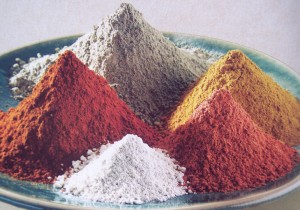Every Dirt Is Different
/>
As I continue to collect different colors of earth I’m starting to realize how different they all are. I may collect two jars of clay that look like the same color but were collected in different locations and when I grind and mix them with walnut oil, their properties are completely different. One may be very transparent and the other opaque or one may be sticky and buttery and the other grainier. Some may require a little oil to make a nice consistency and others seem to just soak it up and require a ton. I’m learning a little bit at a time as I go along.
The specific properties of each pigment vary depending on the composition of the earth where they were collected. Earth pigments are basically clay that contains different forms of iron oxide, plus other minerals. The various combinations of these elements determine the color.
Generally green earth pigment has a weak tinting strength (pretty transparent) but most of the natural earth pigments (the ochres, siennas and umbers) have a medium tinting strength. Umbers and ochres are the most opaque and siennas more transparent. Red iron oxide has a powerful tinting strength.
I’ve purchased several hard to find colors from EarthPigments.com, based in Arizona. They sell pure natural earth clays and also alter certain earth pigments by roasting them to get different colors (for example “burnt” sienna). Both ultramarine blue and red are made from sodium aluminum silicate clays that are then burned with sulfur. I’m holding off from using these drastically altered pigments but atleast they’re natural and non-toxic for those who need these specific colors.

